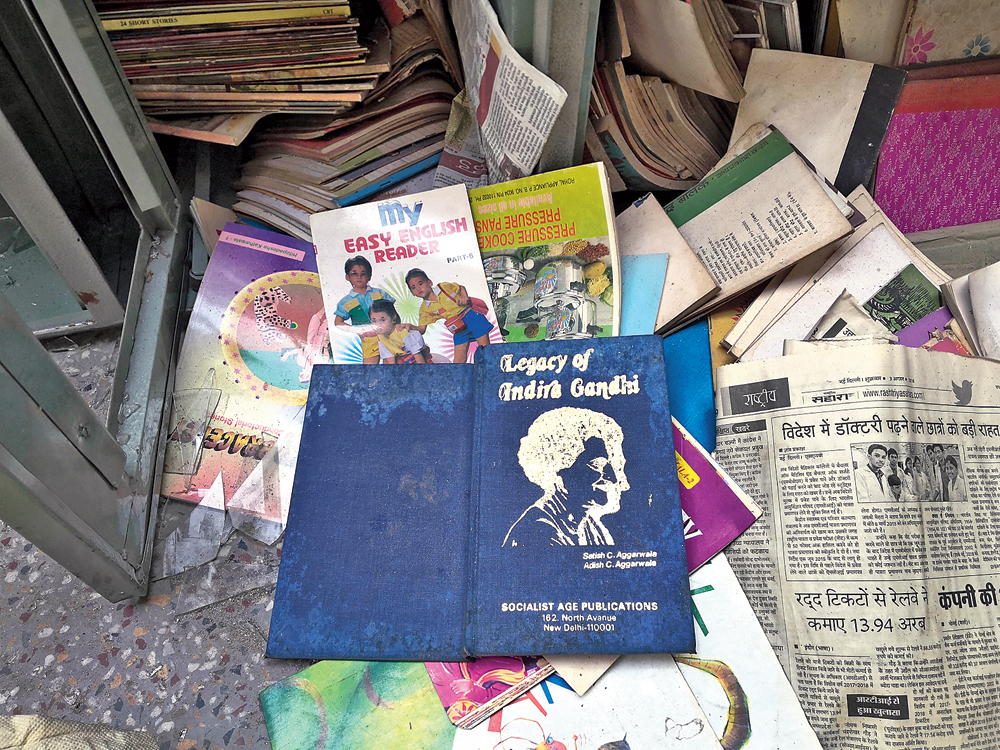A heap of ash from a bonfire of books lies on the floor of the library of Arun Modern Senior Secondary School in northeast Delhi.
Those who set fire to the books on Tuesday afternoon also burned the school office, the principal’s chamber, a bus and two cars parked within its complex.
Next door stands the Farukhi Jama Masjid, a small mosque where, later in the evening on Tuesday, members of a mob armed with hockey sticks, clubs and knives attacked people in prayer and then, according to eyewitnesses, tried to burn it.
Fire has ravaged a part of the mosque’s inner chamber and there were bloodstains in its outer chamber.
Neighbourhood residents say the school and the mosque had both emerged around the same time three decades ago, offering the local population — a fair mix of Hindus and Muslims — in Brijpuri and Mustafabad, two pockets of northeast Delhi, a place for education and a place for worship.
But after communal clashes erupted in nearby Jaffrabad on Monday and spread to Brijpuri on Tuesday, local residents say a standoff between two groups of people spiralled out of control.
Residents hiding in their homes heard gunshots and screams, while the school and the mosque were among an array of other targets — shops, motorbikes and property. “It is saddening — India has been known for people from different religions living together in peace,” Jyoti Rani, Arun school’s principal, told The Telegraph on Thursday.
Rani said: “Such incidents can create suspicions in people’s hearts. We can now only hope that people forget and live in peace.”
The school’s watchman has told her that a mob of around 200 to 300 people broke a lock to enter the school on Tuesday afternoon and spent the next hour there, setting the ground-floor office, parked vehicles and books in the library on fire.
“Only outsiders could have done this — about half of the students in our school are from Muslim homes,” Rani said.
Sections of local residents — Hindus and Muslims — say they are convinced that “outsiders” were behind the attack.
“We’ve lived here side by side for so long — look at us. We eat and drink together, we know each other,” said Wajid Ali Alvi, an electrician who has lived in the area since 1985 and spent Wednesday afternoon with his “friend” and neighbour Sudama Prasad, discussing Tuesday’s incidents.
Several local residents are also convinced that police inaction through Tuesday morning and afternoon allowed the simmering tension and the standoff between two groups of people armed with stones to spiral into unfettered violence. “Let them open the police control room records. I’m sure they’ll find hundreds of calls seeking police help,” a Brijpuri resident said.
Several of the local residents who spoke to this newspaper requested anonymity, fearing reprisal or exposure.
Some who watched the attack on the mosque claim the attackers were either backed by the police or themselves wore police-like uniform with helmets as they turned on the people gathered there for the evening prayers.
“They used hockey sticks, lathis, knives and swords,” said a local resident who asked not to be named. “We could hear the sounds and screams from here. The muezzin was injured very badly. His head was bleeding. There was so much blood.”
By the time the police took control, the attack had left dozens injured. Later that evening, local residents helped carry the injured, including the mosque’s muezzin, to the Al Hind Hospital, the nearest nursing home, about a kilometre away.
“People who do these things are not human, they can’t claim to have a religion,” said a local resident, a clothes trader. “They’re inhuman, they’re beasts.”











